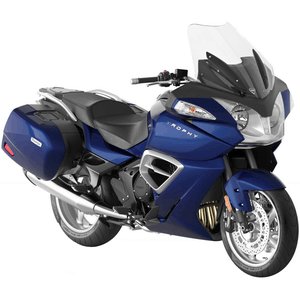Triumph Trophy 1200 (2013-2017): A Sport-Touring Powerhouse Revisited

When Triumph unveiled the Trophy 1200 in 2012, it wasn’t just entering the touring segment—it was declaring war on complacency. Designed to rival established giants like BMW and Yamaha, the Trophy 1200 SE (2013–2017) blends British engineering flair with cutting-edge tech, creating a machine that’s as capable on Alpine switchbacks as it is on transcontinental hauls. Having recently spent time with a well-maintained 2016 model, here’s why this bike remains a compelling choice for riders who refuse to compromise.
The Heart of the Beast: Engine and Performance
At the core of the Trophy 1200 lies its 1,215cc inline-three engine—a masterpiece of balance and character. Producing 134.6 hp at 8,900 rpm and 120 Nm (88.5 lb-ft) of torque at 6,450 rpm, this powerplant delivers acceleration that’s both urgent and refined. The triple’s signature growl transitions into a howl as the revs climb, yet it never feels strained, even when two-up with luggage.
Ride-by-wire throttle ensures silky response, whether you’re navigating city traffic or carving through mountain passes. The shaft drive eliminates chain maintenance headaches, and Triumph’s torsional damping system mitigates the “jerkiness” often associated with shaft-driven bikes. Sixth gear is tall enough to hover at 110 km/h (68 mph) at just 4,000 rpm, making highway slogs surprisingly serene.
Fuel efficiency? Expect 5.1 L/100 km (54.5 mpg) at steady cruising—a figure that translates to over 400 km (250 miles) from its 26-liter (6.9-gallon) tank.
Chassis and Handling: Precision Meets Comfort
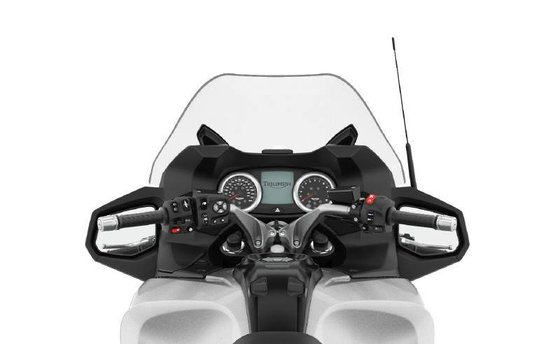
Triumph’s aluminum twin-spar frame strikes a rare balance between rigidity and compliance. Paired with WP electronic suspension (standard on the SE), the Trophy adapts seamlessly to load and terrain. Flick the left-hand toggle to adjust damping between Comfort, Normal, and Sport, or tweak rear preload for solo, luggage-heavy, or two-up riding.
On twisty roads, the Trophy defies its 315 kg (694 lbs) wet weight. Steering is neutral and intuitive, with a 27-degree rake and 119 mm (4.7 in) of trail contributing to stability without dulling agility. The Bridgestone Battlax tires (120/70-17 front, 190/55-17 rear) offer ample grip, though spirited riders might upgrade to stickier rubber for track-inspired confidence.
Tech and Comfort: Touring, Redefined
Ergonomics
The Trophy’s riding position is a masterclass in ergonomics. The seat adjusts between 800–820 mm (31.5–32.3 in), accommodating shorter riders without cramping taller ones. Heated grips and seats (standard on the SE) are a godsend in chilly conditions, while the electrically adjustable windscreen rises 164 mm (6.5 in) to create a near-silent cockpit.
Electronics Suite
- Traction control: Discreetly intervenes on slippery surfaces without feeling intrusive.
- Cruise control: Effortless to set via handlebar buttons—perfect for long highway stretches.
- Tire Pressure Monitoring System (TPMS): Eliminates guesswork during pre-ride checks.
- Bluetooth audio system: Syncs with your phone for music or navigation prompts. Sound quality? Respectable at lower speeds, though wind noise drowns it out above 130 km/h (80 mph).
Luggage Solutions
The Dynamic Luggage System isn’t just spacious (31L panniers + optional 55L top box)—it’s smart. By allowing panniers to pivot independently, Triumph reduces chassis disturbance, ensuring the bike remains stable even when fully loaded.
Competition: How Does the Trophy Stack Up?
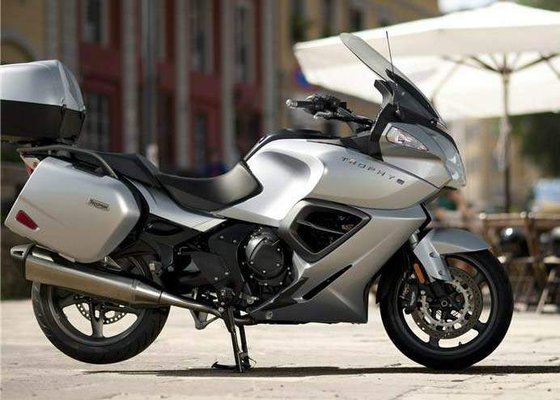
BMW K1600GT
- Pros: The BMW’s 1,649cc inline-six is buttery smooth, and its adaptive headlight is peerless.
- Cons: Heavier (718 lbs vs. Trophy’s 694 lbs) and costlier, especially with optional electronic suspension.
- Verdict: The K1600GT is the tech king, but the Trophy counters with agility and value.
Yamaha FJR1300
- Pros: Lighter (628 lbs) and more affordable, with a torquey 1,298cc inline-four.
- Cons: Outdated analog gauges, no electronic suspension, and a cramped riding position.
- Verdict: A solid workhorse but lacks the Trophy’s modern polish.
Triumph’s Edge
While the BMW dazzles with luxury and the Yamaha leans on legacy, the Trophy splits the difference. Its triple-cylinder engine offers a unique blend of character and efficiency, while the standard electronic suspension gives it a handling edge. For riders seeking a connected touring experience—one where feedback matters as much as comfort—the Triumph shines.
Maintenance: Keeping Your Trophy in Peak Form
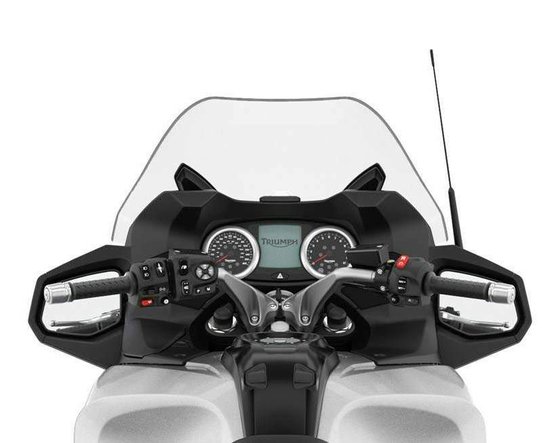
Key Service Points
- Oil changes: Every 10,000 km (6,200 miles) with 4L of 10W-40 synthetic.
- Shaft drive: Inspect seals annually; grease the universal joint every 30,000 km (18,600 miles).
- Brakes: Nissin calipers are durable, but swap pads early if you ride aggressively. OEM part #T2345900.
- Tires: Stock Battlax tires last 8,000–10,000 km (5,000–6,200 miles). Consider Metzeler Roadtec 01 for longer wear.
Common Upgrades
- Suspension tweaks: WP’s stock setup is great, but a Wilbers shock ($850) enhances two-up comfort.
- LED lighting: Boost visibility with MOTOPARTS.store’s Denali D4 2.0 lights ($299).
- Aftermarket exhaust: A Remus Hexacone ($1,150) amplifies the triple’s soundtrack without sacrificing luggage space.
Troubleshooting Tips
- ABS module whine: Normal on startup; don’t panic.
- Clutch shudder: Common in early models. Upgrade to Barnett clutch plates ($220) for smoother engagement.
Final Thoughts
The Triumph Trophy 1200 isn’t just a motorcycle—it’s a passport to horizons near and far. Its blend of soulful performance, tech-forward features, and Touratech-level practicality makes it a standout even today. While BMW and Yamaha have their merits, the Trophy’s charisma and value proposition endure.
Whether you’re prepping for a cross-country adventure or simply craving a bike that does it all, the Trophy 1200 deserves a spot in your garage. And when it’s time to personalize or maintain your steed, remember: MOTOPARTS.store has the gear to keep your Triumph towering above the rest.
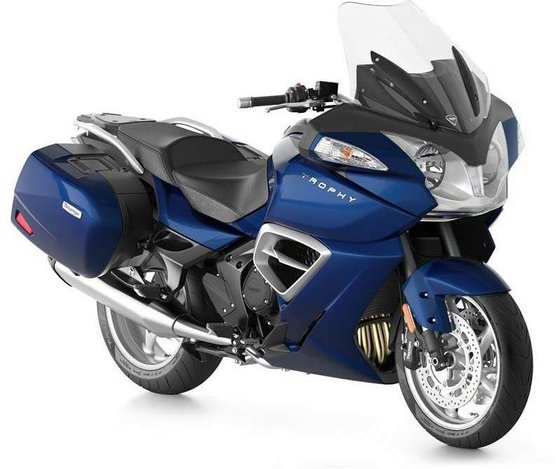




Specifications sheet
| Engine | |
|---|---|
| Stroke: | Four-stroke |
| Max power: | 99 kW | 133.0 hp |
| Max torque: | 120 Nm |
| Fuel system: | Ride-by-wire fuel injection |
| Max power @: | 8900 rpm |
| Spark plugs: | NGK DPR8EA-9 |
| Displacement: | 1215 ccm |
| Max torque @: | 6450 rpm |
| Oil capacity: | 4.0 |
| Configuration: | Inline |
| Cooling system: | Liquid-cooled |
| Compression ratio: | 11.0:1 |
| Number of cylinders: | 3 |
| Dimensions | |
|---|---|
| Wheelbase: | 1542 mm (60.7 in) |
| Dry weight: | 294 |
| Wet weight: | 315 |
| Seat height: | 800–820 mm (31.5–32.3 in) |
| Overall width: | 858 mm (33.8 in) |
| Overall height: | 1435 mm (56.5 in) |
| Overall length: | 2235 mm (88.0 in) |
| Ground clearance: | 165 mm (6.5 in) |
| Fuel tank capacity: | 26 L (6.9 US gal) |
| Drivetrain | |
|---|---|
| Clutch: | Wet multi-plate |
| Final drive: | shaft |
| Transmission: | 6-speed constant mesh |
| Electronics | |
|---|---|
| ABS: | Non-switchable linked system |
| Lighting: | Electrically adjustable headlight |
| Cruise control: | Electronic (standard) |
| Instrumentation: | Dual analog gauges with LCD display, gear indicator, heated grip/seat status, TPMS, and audio controls |
| Traction control: | Standard |
| Suspension adjustment: | Electronic front/rear |
| Maintenance | |
|---|---|
| Engine oil: | 10W40 |
| Brake fluid: | DOT 4 |
| Spark plug gap: | 0.7 |
| Final drive oil: | SAE 75W-90 GL-5 |
| Coolant capacity: | 3.0 |
| Engine oil capacity: | 4.0 |
| Engine oil change interval: | Every 10,000 miles (16,000 km) with major services every 20,000 miles |
| Valve clearance (intake, cold): | 0.10–0.20 mm |
| Valve clearance check interval: | 24,000 km (15,000 mi) |
| Valve clearance (exhaust, cold): | 0.20–0.30 mm |
| Recommended tire pressure (rear): | 2.9 bar (42 psi) |
| Recommended tire pressure (front): | 2.5 bar (36 psi) |
| Chassis and Suspension | |
|---|---|
| Rake: | 27.0° |
| Frame: | Aluminum twin-spar with single-sided swingarm |
| Trail: | 119 mm (4.7 in) |
| Rear tire: | 190/55 z-17 |
| Front tire: | 120/70 z-17 |
| Rear brakes: | Single 282mm disc, Nissin 2-piston caliper, ABS |
| Front brakes: | Dual 320mm floating discs, Nissin 4-piston calipers, linked ABS |
| Rear suspension: | WP monoshock with electronically adjustable hydraulic preload (1up/1up+luggage/2up) and rebound damping |
| Front suspension: | WP 43mm upside-down forks, electronically adjustable rebound damping (comfort/sport/normal) |
| Rear wheel travel: | 120 mm (4.7 in) |
| Front wheel travel: | 127 mm (5.0 in) |



